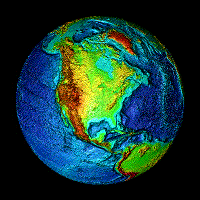

Persistent Geo-Blunder Discovered: Huge Boost for Oil and Gas Exploration
Press Release
  Persistent Geo-Blunder Discovered: Huge Boost for Oil and Gas Exploration Press Release |
SAN DIEGO,
March 25, 2010 –
For decades, an unsuspected geological blunder has limited crucial technical
understanding of how, where and why petroleum and natural gas deposits form.
Exposing and correcting that vital mistake offers the promise of new insights
and potentially vast new energy-resource discoveries.
Since the 1930s, the idea of mantle convection has been inextricably rooted in
common geological interpretations of Earth’s dynamics. In a paper just published
in the March 25, 2010, issue of Current
Science, San Diego geophysicist J. Marvin Herndon of Transdyne Corporation
discloses a very serious problem with the prevailing concept of convection in
the Earth’s mantle and reveals the profound implications on oil and gas
exploration.
For decades geologists and geophysicists have assumed that convection occurs
within the Earth’s mantle. But according to Herndon’s discovery, Earth-mantle
convection is physically impossible. As he explains in his paper, the mantle is
compressed by its own weight and the weight of the crust, so that its bottom is
about 62% more dense than the top. The negligible amount of thermal expansion
that might occur at the bottom, less than 1%, cannot cause bottom-mantle matter
to float to the surface or make the mantle top-heavy, necessary conditions for
convection.
Herndon’s discovery has revolutionary implications for geologists, who have for
decades misapplied mathematical convection-justification relationships to the
gravity-compressed mantle; such relationships are only valid for incompressible
fluids.
Familiar topical names, such as Pangaea, Gondwanaland and Plate Tectonics, will
begin to fade into history, replaced by a more correct 21st Century
understanding of geology and geodynamics without mantle convection.
In Herndon’s view, virtually all major geological activity is the consequence of
a single process: Earth-crust fragmentation – splitting the Earth’s crust to
form new surface area to accommodate decompression-increased planetary volume.
Crustal fragmentation, called rifting, provides all of the crucial components
for petroleum-deposit formation: basin, reservoir, source, and seal. Rifting
causes the formation of deep basins, as presently occurring in the Afar triangle
of Northeastern Africa. Augmented by heat channeled upwards from deep within the
Earth, uplift from sub-surface swelling can sequester sea-flooded lands to form
halite evaporate deposits, lead to dome formation, and can make elevated land
susceptible to erosion processes, thus providing sedimentary material for
reservoir rock in-filling of basins. Moreover, crustal fragmentation potentially
exposes deep basins to sources of abiotic mantle methane and, although still
controversial, methane-derived hydrocarbons.
Drawing upon an understanding he developed with respect to the East African Rift
System and the underlying rifting and extensive petroleum and natural gas
deposits associated with the Siberian Traps, Herndon predicts the extensively
rifted region beneath the Deccan Traps of India will become the site of
important energy-resource discoveries. In fact, the first discovery has already
been reported.
For more information:
http://www.NuclearPlanet.com/oil.html
For pdf of paper:
http://www.NuclearPlanet.com/boost.pdf
Source:
J. Marvin Herndon, Ph.D.
Transdyne Corporation
Email:
mherndon@san.rr.com
Website:
http://www.NuclearPlanet.com
###